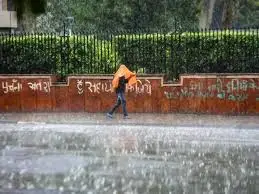IMD to receive high resolution Bharat Forecast System today

The Indian Meteorological Department (IMD) will receive a major technology upgrade today. The new system, called the high-resolution Bharat Forecast System (BFS), promises to transform weather forecasting in India. It will provide more accurate, timely, and localized weather information. This upgrade marks a significant step in India’s efforts to improve disaster management, agricultural planning, and public safety.
What is the Bharat Forecast System?
The Bharat Forecast System is a cutting-edge weather prediction model developed by Indian scientists, with help from international experts. It uses the latest advancements in meteorology, artificial intelligence, and supercomputing. Unlike older models, BFS can offer hyper-localized forecasts. This means it can predict weather for small regions, even down to the village level.
BFS collects massive amounts of data from satellites, Doppler radars, weather stations, and ocean buoys. It then processes this data through advanced techniques that ensure real-time accuracy. As a result, meteorologists can rely on highly precise weather predictions.
Why is the Bharat Forecast System Important?
India’s diverse geography, which includes coastlines, mountains, and plains, makes weather prediction very complex. Accurate forecasts are essential to reduce damage from cyclones, floods, droughts, and heatwaves. BFS addresses these challenges in several ways:
- High Resolution and Precision: BFS offers forecasts with a resolution of just a few kilometers. This improvement allows meteorologists to pinpoint the exact location and strength of weather events.
- Earlier Warnings: The system gives authorities more lead time to warn people about upcoming cyclones, heavy rains, or heatwaves. This extra time helps save lives and property.
- Support for Farmers: Since agriculture depends heavily on weather, farmers benefit greatly. With detailed forecasts, they can decide the best times for sowing, watering, and harvesting.
- Disaster Preparedness: Better forecasts enable government agencies to prepare in advance. They can organize evacuations and mobilize resources more effectively.
Technical Features of the Bharat Forecast System
BFS runs complex mathematical models that simulate the atmosphere. It uses supercomputers to process huge amounts of data quickly, which ensures forecasts remain current and reliable.
Key features include:
- Multi-scale Modelling: BFS combines regional and local models to cover both large weather systems and small-scale events.
- Real-time Data Use: The system constantly updates itself with new observations.
- AI and Machine Learning: These tools help BFS improve over time by learning from past weather patterns.
- User-friendly Forecasts: BFS outputs are designed for easy use by government officials, farmers, and disaster response teams.
Impact on Key Sectors
The BFS will benefit many areas in India:
Agriculture
India’s farmers face risks from unpredictable weather. Floods, droughts, and unseasonal rains can destroy crops and livelihoods. By providing precise weather information, BFS will help farmers plan better and reduce losses.
Disaster Management
India often experiences cyclones, floods, and heatwaves. BFS will allow the IMD to issue earlier and more accurate warnings. This will help governments plan evacuations and rescue operations, reducing the impact of disasters.
Aviation and Transportation
Weather affects flight safety and schedules. BFS will give aviation authorities better data to avoid weather-related disruptions. Similarly, road and rail networks will benefit from timely weather alerts to improve safety.
Urban Planning and Public Health
Cities will use BFS data to manage heatwaves, water supply, and air quality. Hospitals can prepare for heat-related illnesses, while city planners can address flood risks more effectively.
A Milestone in India’s Meteorological Modernization
The Bharat Forecast System is part of India’s broader effort to upgrade its meteorological capabilities. Over the last decade, IMD has improved its satellites, radar network, and computing power. BFS builds on these improvements and places India among the world’s leaders in weather forecasting.
This effort aligns with the government’s goal of using technology to support sustainable development. BFS’s accurate and localized forecasts help programs like the National Disaster Management Authority and the Pradhan Mantri Fasal Bima Yojana.
Expert Opinions
Dr. Anjali Verma, a senior meteorologist at IMD, called BFS a “game changer.” She said, “With this system, we can track weather more precisely. This will help protect lives and property, especially in vulnerable areas.”
Climate scientists also highlight BFS’s value for research. The system’s detailed data will improve climate modeling. This can guide policies for climate change mitigation and adaptation.
What Comes Next?
As IMD begins using the Bharat Forecast System, the focus will shift to training staff and integrating BFS into daily operations. Public awareness campaigns will ensure that citizens understand and trust the new forecasts. As access to precise weather data grows, India will improve its preparedness for weather-related challenges.
Conclusion
The high-resolution Bharat Forecast System marks a huge step forward for India’s weather forecasting. It will provide accurate, localized, and timely forecasts that help reduce the harm caused by extreme weather. This system reflects India’s growing strength in scientific innovation and its commitment to resilience.
With BFS, sectors such as agriculture, disaster management, transportation, and public health will benefit greatly. India is now better equipped to face weather uncertainties with confidence.






